Nouns, Nouns, Nouns: The Wild Robot Chapters 9-13 Study Guide
This post contains paid links. I may get a commission if you decide to make a purchase through my links, at no extra cost to you. Thank you for helping towards the cost of hosting and maintaining this website.
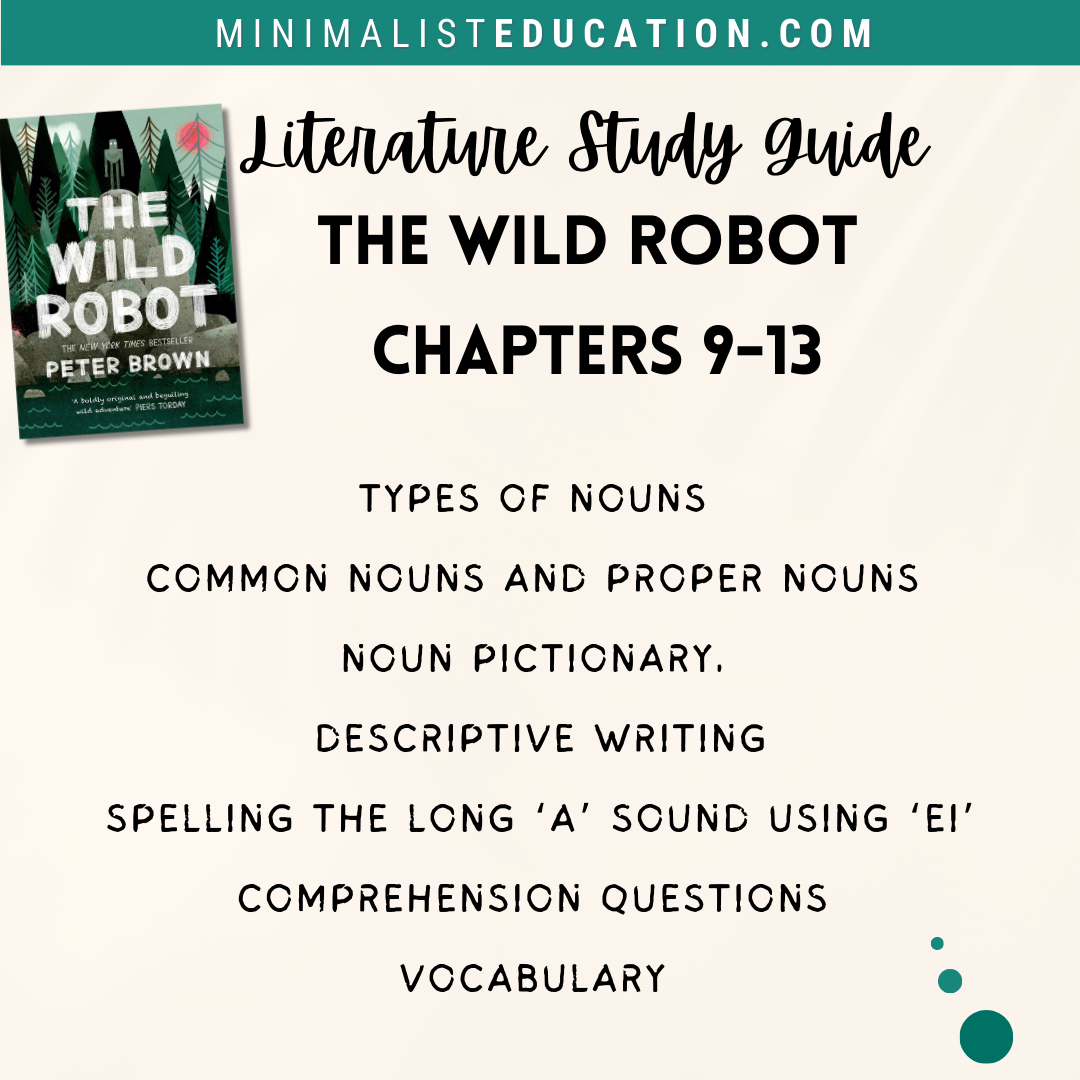
Types of nouns, common nouns and proper nouns, noun Pictionary, a descriptive writing activity, spelling the long ‘a’ sound using ‘ei, comprehension questions, and activities to learn and consolidate vocabulary. This is what you can expect in this weeks The Wild Robot literature study guide based on Chapters 9-13.
Welcome to the second week of The Wild Robot Literature Study Guide.
You can read my introduction and links to The Wild Robot study guide here.
In this post:
- The Wild Robot teaching notes and answers for Week 2 Chapters 9-13.
- Download The Wild Robot Study Guide for Week 2 Chapters 9-13.
Get your copy of The Wild Robot
Buy a copy of “The Wild Robot” (Amazon Link).
The Wild Robot Chapters 9-13 Study Guide Teaching Notes And Answers

Read Chapters 9-11:
- Ex. 1 Answer the comprehension questions based on the three chapters read. These can be discussed first before writing.
In this comprehension exercise, I have included literal comprehension questions and an opinion question. The literal comprehension questions require your child to recall specific details directly stated in the text. They focus on the ability to understand and remember facts and information from the text. The opinion question asks your child to express their opinion and give a reason for their answer based on their comprehension of the story.

- Read the notes on the grammar focus this week – nouns.
If your child has a strong understanding of what nouns are, you can quickly recap the information on the page and they can move straight on to the related exercises.
If your child hasn’t formally encountered what nouns are, you can use this opportunity to spend a bit of time on this section.
Some notes on Teaching Common Nouns
Introduce the definition- which probably won’t make sense without some concrete examples: nouns are words that name people, places, things, and ideas.
You can elaborate on each category. For example:
What do you call a person who teaches children in a school?
Teacher.
The word teacher is a noun that names a person.
What do you call a person who is the the father of your dad?
Grandfather.
The word grandfather in a noun that names a person.
Nouns can also be words that name a place. What do you call a place where you can borrow books from?
A Library.
Library is a noun that names a place.
And so on.
Nouns which name ideas can be an abstract concept. While we can name ideas, you can’t see it. Some examples of nouns which are ideas are love, hunger, excitement, sadness.
Some notes on Teaching Proper Nouns
Explain nouns are naming words. Some examples of nouns that name people are mother, father, doctor, postman, boy, girl, children. These are common nouns. They name many people.
There are many boys in the world. Many fathers, many mothers, many doctors, many postmen, many girls, many children.
Explain, however, that they are not are not just any child. Your child has a name. This is their own special name. This is is a proper noun. Proper nouns start with a capital letter to show they refer to a specific person, place, thing or idea.
You can then have a conversation about different groups of common nouns and examples of proper nouns within that category. For example going to the shops. The word shop is a common noun, and then give the proper name of the shops that you might go to. Write them down, so they can see how the word shop isn’t normally capitalised but the specific names of shops are.
Exercises to practice identifying types of nouns
- Ex. 2. Write the nouns given in the correct columns, either common noun or proper noun.
An obvious way to know if a noun is a common noun or proper noun in this exercise is to see if starts with a capital letter or not.
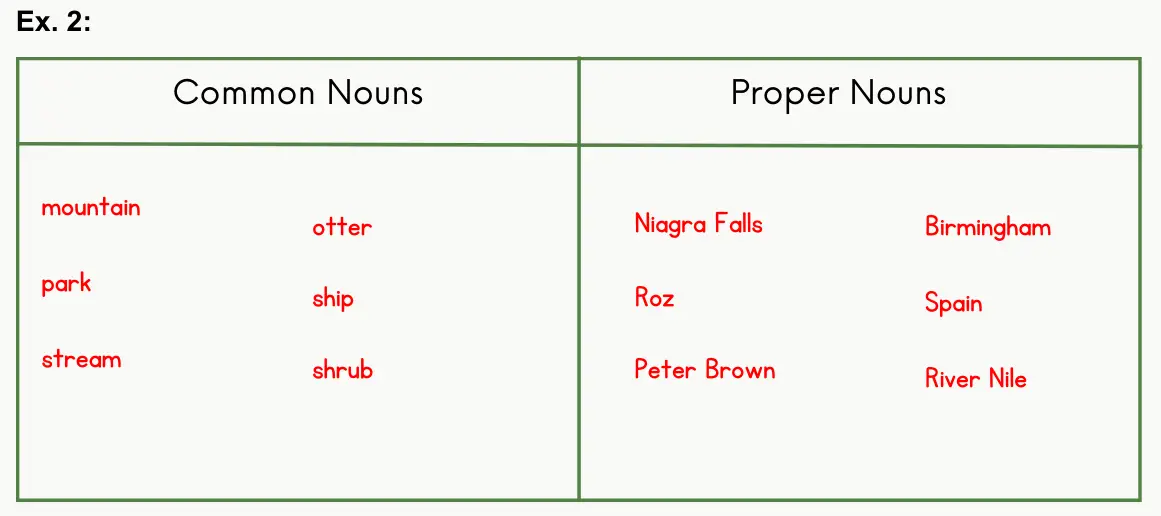
- Ex. 3. Underline one noun from each sentence. Write down if they name a person, place, thing or idea.
In this exercise children get to practice recognising nouns in sentences. They also have the chance to identify what type of noun the word is- a person, place, thing or idea.
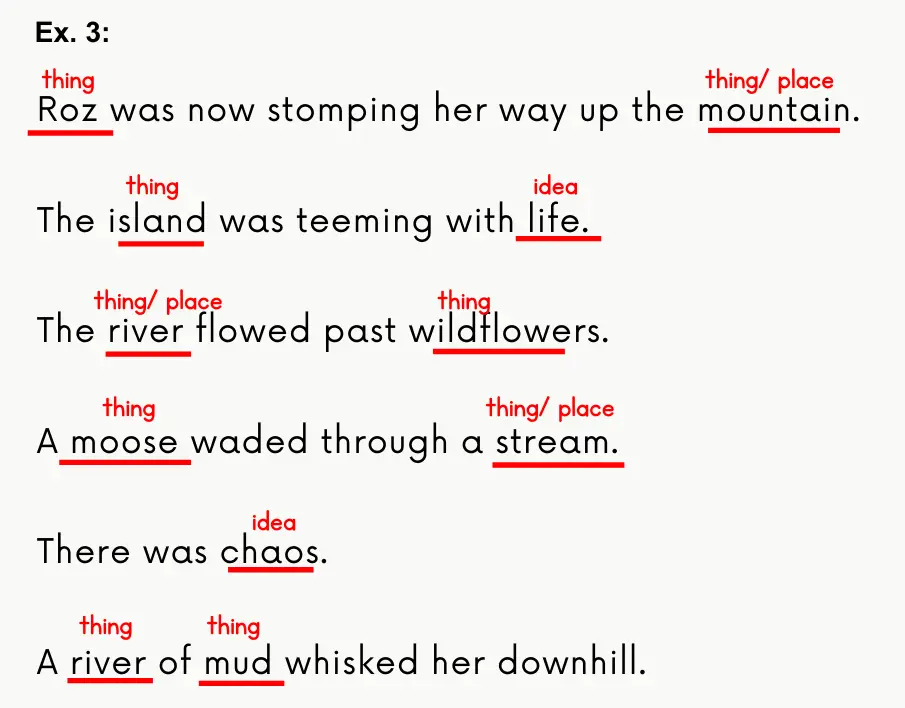
- Ex 4 Play Noun Pictionary
To consolidate the concept of nouns, play ‘Noun Pictionary’! You will need pencil/ pen, paper or a whiteboard (to draw on), and a timer.
Chose a person to be the drawer and the other person to be the guesser.
The drawer chooses a noun from “The Wild Robot”. Start the timer for 1 minute and begin drawing. The guesser has to correctly guess the noun being drawn within the time limit.
Swap roles so both players have a turn drawing and guessing.
If you have enough people (at least 4), you can make this game competitive by making two teams. One team chooses a drawer, and their team members have to guess the noun within the time limit. If they guess the word they score a point. Then the other team chooses a drawer, while their team tries to guess the noun within the time limit.
Read Chapters 12-13:
- Read the extract and related analysis.
“Deer were wading through the flooded fields. Beavers were busily collecting a trove of fallen branches. Geese honked in the sky before splashing down into a watery section of the forest.” Chapter 13 page 31
This extract is perfect for showing children how to describe with more detail. In this extract Brown uses nouns to set the scene and create a vivid picture of the environment.
- Ex. 1 Underline the nouns in this passage.
This exercise allows kids to practice identifying nouns in the context of a passage of writing.
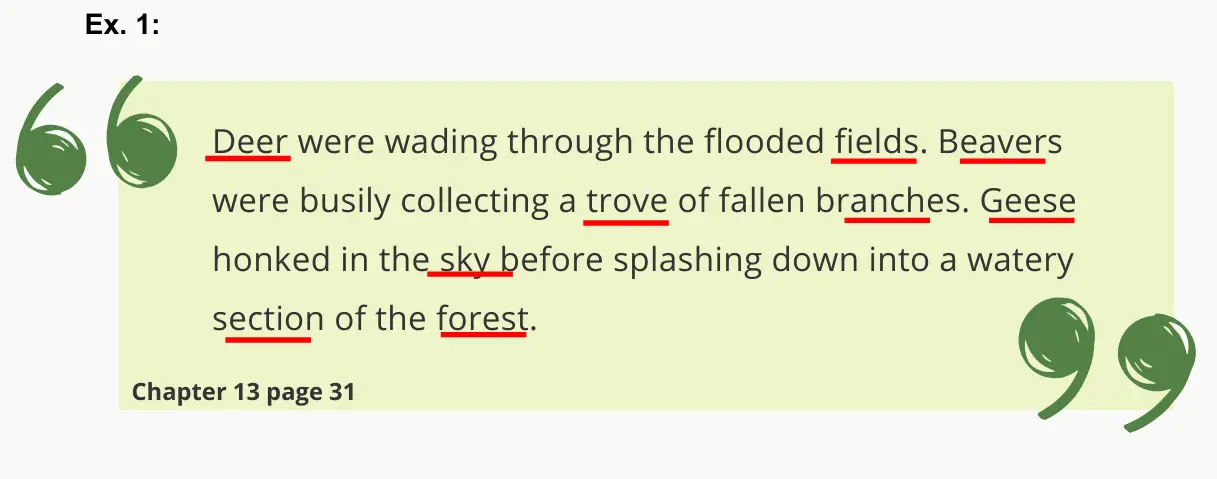
- Ex. 2 Create a descriptive passage using nouns to establish a vivid scene.
In this creative writing exercise, children will be using a picture prompt to do some descriptive writing. I’ve given a list breaking down the task to make it easier.
Kids can find a picture of a natural setting with wildlife. They list all of the nouns they can identify in the picture. Then they write their own descriptive paragraph based on the picture using at least three of their nouns to create a detailed, vivid scene.
- Ex. 3 Solve this crossword puzzle. All of the words use the ‘ei’ spelling for the long /a/ sound.
Spelling this week is continuing the theme of the long ‘a’ sound from last week.
This week kids will learn and practice spelling the long ‘a’ sound using the spelling ‘ei’.
When the letters ‘e’ and ‘i’ are next to each other in a word, they make the long ‘a’ sound, just like the “ay” sound.
Example words: eight, weight, neighbour, vein, freight
You might want to generate the ‘ei’ words for the crossword with your child before hand on a piece of paper for them to refer to if they are not confident with completing the crossword independently.
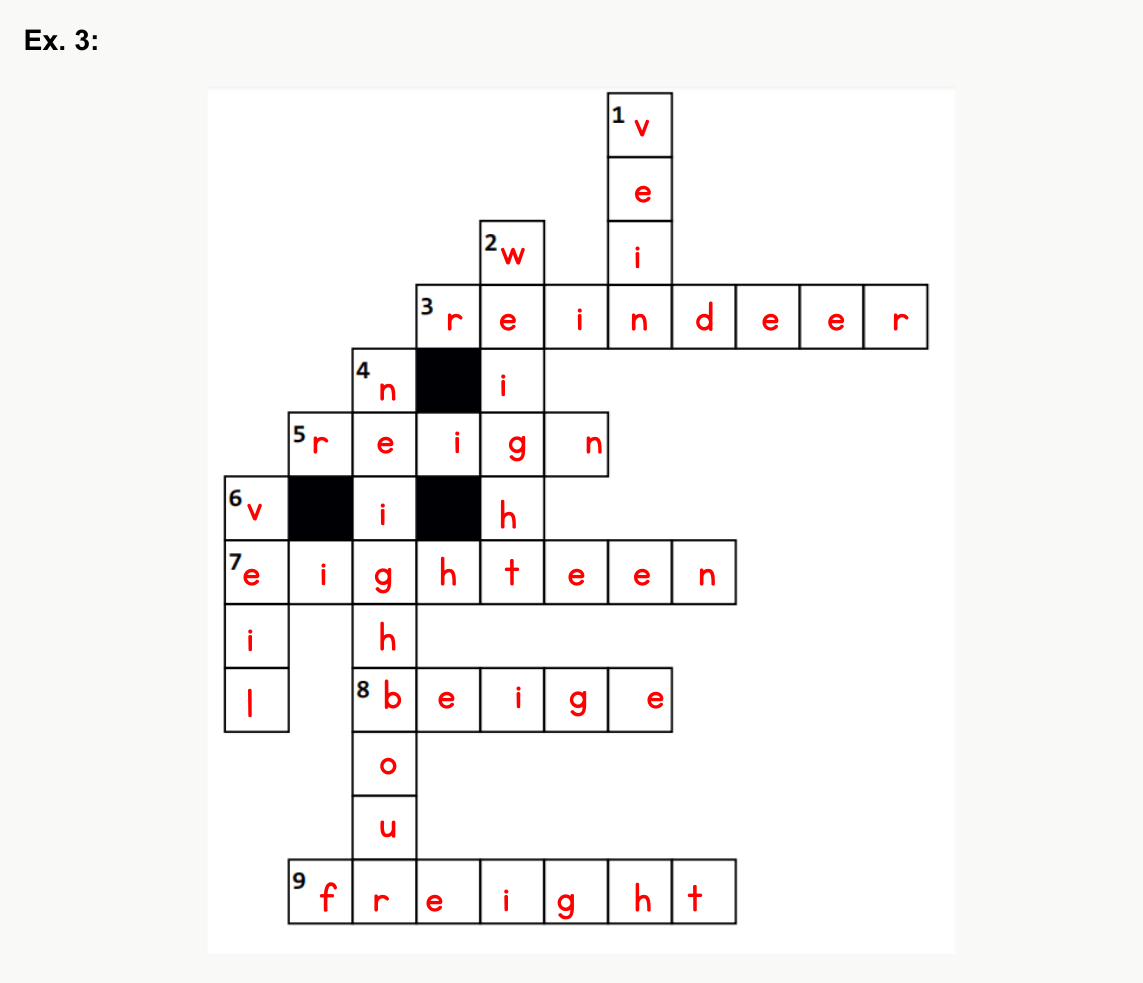
Note: I use the British spelling conventions. If you are using this guide outside of the UK, neighbour (and others) might be spelt differently.
This is what we British homeschoolers have to contend with all the time when using American based resources – welcome to our world!
- Ex. 4 Match the vocabulary words taken from this week’s chapters in The Wild Robot with the correct definition.
Children can use a dictionary for this exercise if they need to. This is a perfect opportunity to show them how to use it.
I’ve tried to select common words that can be incorporated into everyday use. The way to really help expand children’s vocabulary is by using it ourselves when we speak.
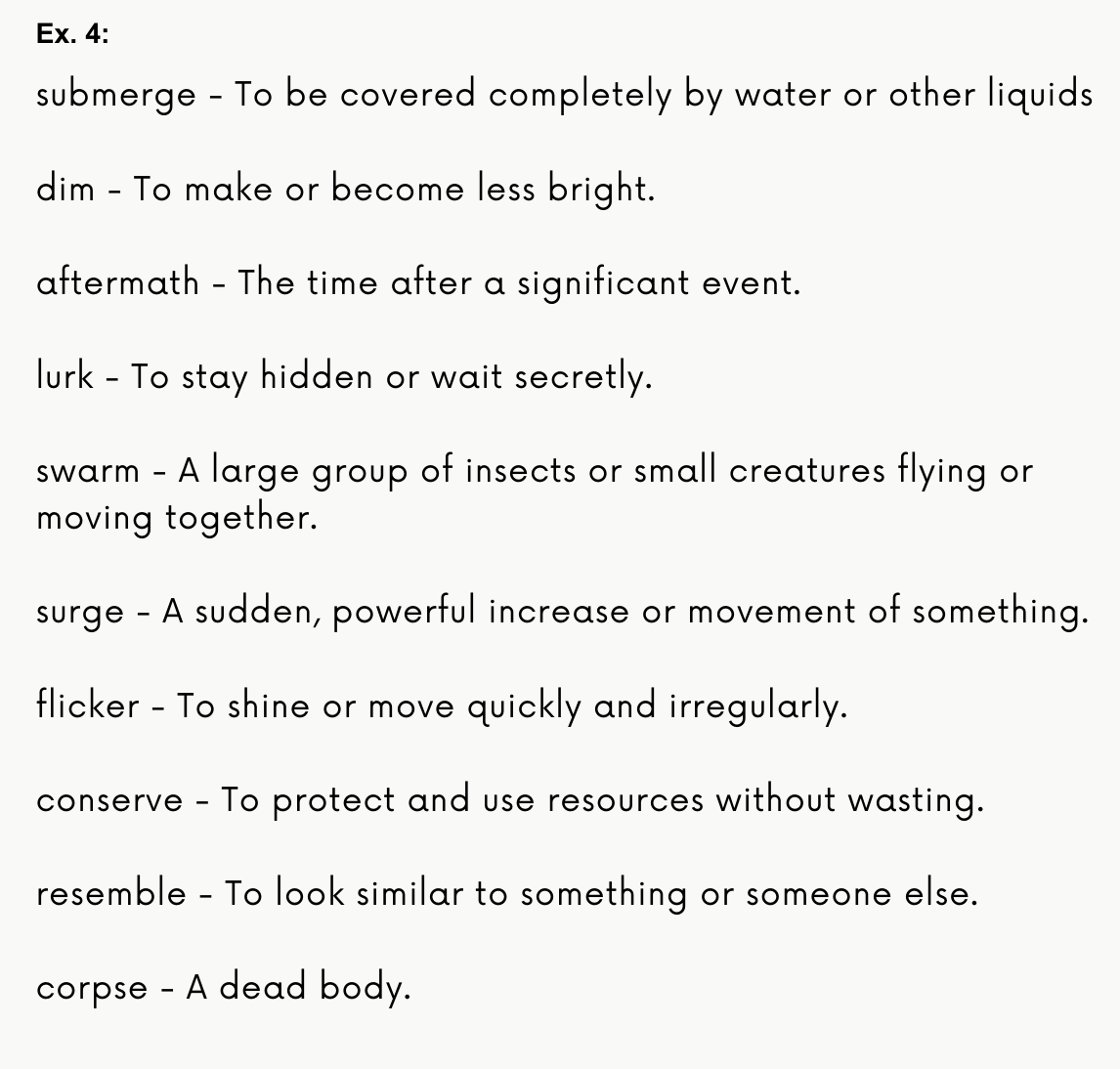
Here are some everyday instances where you might use these words. Which I admit might not sound casual and everyday but will help consolidate the new vocabulary!
“When we go swimming, we can watch as objects submerge under the water, like a boat sinking.”
“Let’s turn off the light in your room to make it more dim and more comfortable to sleep.”
“This room is so messy it looks like the aftermath of a tornado!”
“Can you see if any creepy crawlies are lurking in the bushes?”
“Let’s pick up the cookie crumbs from the floor before we get a swarm of ants in our house.”
“Just when you hugged me, I felt happiness surge through my body!”
“Why is one of my eyes flickering?” (while madly winking)
“We should conserve energy by turning off the light when we don’t need it.”
“You and your sister resemble each other so much; you could almost be twins!”
“In the spooky movie, they discovered a hidden treasure next to a mysterious corpse.”
- Ex 4 Choose 5 of the vocabulary words and write sentences with them. Each sentence should have 5 words or more.
Using the new vocabulary in their own sentences will help consolidate it and give them more confidence in using those words.
Download Your Copy of The Wild Robot Study Guide for Chapters 9-13:
I hope this helps some of you out!
We are tracking along with you and it’s one my boys favorite part of school. Thank you again!
Children are so discerning, so that’s high praise indeed!
Thanks for the great resources. Finding this guide really useful.
Thanks for commenting! It is so helpful to know that the resource is useful.